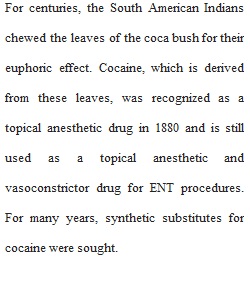


Q 1. Describe some historical milestones in the discovery of anesthetic drugs. 2. Define these words and phrases: anesthesia, epidural anesthesia, general anesthesia, induction of anesthesia, regional anesthesia. 3. What is the significance of the abbreviation MPF as seen in the trade name of some anesthetic drugs? 4. Why is epinephrine not added to the anesthetic drug lidocaine for anesthesia during procedures on the fingers? 5. Describe five categories of drugs that are given preoperatively and their therapeutic effects. 6. If a Schedule II narcotic drug is used to induce general anesthesia, why does the patient not become addicted? 7. Describe the difference in the therapeutic effects of these drugs given to produce general anesthesia: ultrashort-acting barbiturate drugs, narcotic drugs, inhaled anesthetic gases. 8. Name several inhaled gases that are used to maintain general anesthesia. 9. What is the therapeutic effect of neuromuscular blocker drugs? 10. To what category does each of the following drugs belong and what is its therapeutic effect? a. desflurane (Suprane) b. fentanyl c. hydroxyzine (Vistaril) d. lidocaine (Xylocaine) Spelling Tips fentanyl Novocain e. meperidine (Demerol) f. methohexital (Brevital) g. sufentanil (Sufenta) h. vecuronium (Norcuron) Chapter Review/Quiz Yourself
View Related Questions